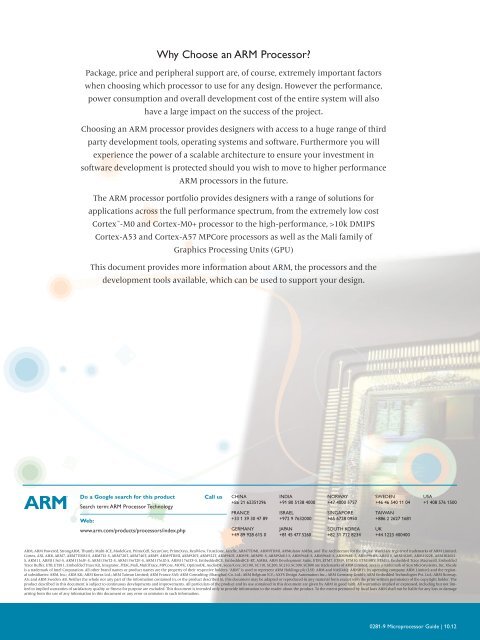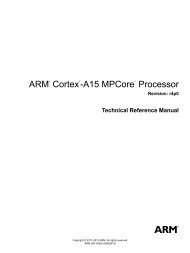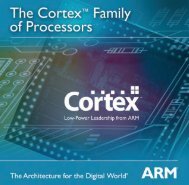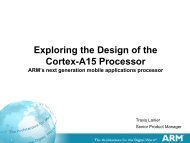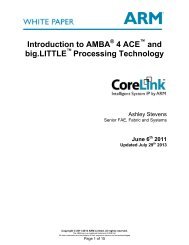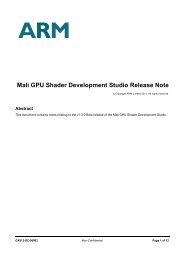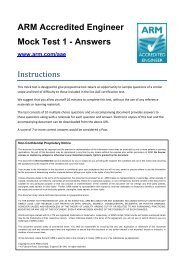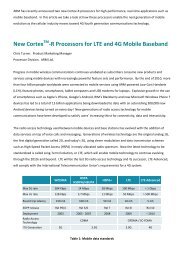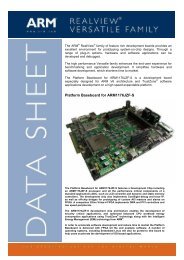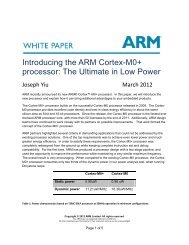Cortex Processor Guide - ARM
Cortex Processor Guide - ARM
Cortex Processor Guide - ARM
Create successful ePaper yourself
Turn your PDF publications into a flip-book with our unique Google optimized e-Paper software.
Why Choose an <strong>ARM</strong> <strong>Processor</strong><br />
Package, price and peripheral support are, of course, extremely important factors<br />
when choosing which processor to use for any design. However the performance,<br />
power consumption and overall development cost of the entire system will also<br />
have a large impact on the success of the project.<br />
Choosing an <strong>ARM</strong> processor provides designers with access to a huge range of third<br />
party development tools, operating systems and software. Furthermore you will<br />
experience the power of a scalable architecture to ensure your investment in<br />
software development is protected should you wish to move to higher performance<br />
<strong>ARM</strong> processors in the future.<br />
The <strong>ARM</strong> processor portfolio provides designers with a range of solutions for<br />
applications across the full performance spectrum, from the extremely low cost<br />
<strong>Cortex</strong> -M0 and <strong>Cortex</strong>-M0+ processor to the high-performance, >10k DMIPS<br />
<strong>Cortex</strong>-A53 and <strong>Cortex</strong>-A57 MPCore processors as well as the Mali family of<br />
Graphics Processing Units (GPU)<br />
This document provides more information about <strong>ARM</strong>, the processors and the<br />
development tools available, which can be used to support your design.<br />
Do a Google search for this product<br />
Search term: <strong>ARM</strong> <strong>Processor</strong> Technology<br />
Web:<br />
www.arm.com/products/processors/index.php<br />
Call us<br />
CHINA<br />
+86 21 62351296<br />
FRANCE<br />
+33 1 39 30 47 89<br />
GERMANY<br />
+49 89 928 615 0<br />
INDIA<br />
+91 80 5138 4000<br />
ISRAEL<br />
+972 9 7632000<br />
JAPAN<br />
+81 45 477 5260<br />
NORWAY<br />
+47 4000 5757<br />
SINGAPORE<br />
+65 6728 0950<br />
SOUTH KOREA<br />
+82 31 712 8234<br />
SWEDEN<br />
+46 46 540 11 04<br />
TAIWAN<br />
+886 2 2627 1681<br />
UK<br />
+44 1223 400400<br />
USA<br />
+1 408 576 1500<br />
<strong>ARM</strong>, <strong>ARM</strong> Powered, Strong<strong>ARM</strong>, Thumb, Multi-ICE, ModelGen, PrimeCell, SecurCore, PrimeXsys, RealView, TrustZone, Jazelle, <strong>ARM</strong>7TDMI, <strong>ARM</strong>9TDMI, <strong>ARM</strong>ulator AMBA, and The Architecture for the Digital World are registered trademarks of <strong>ARM</strong> Limited.<br />
<strong>Cortex</strong>, AXI, AHB, <strong>ARM</strong>7, <strong>ARM</strong>7TDMI-S, <strong>ARM</strong>7EJ-S, <strong>ARM</strong>720T, <strong>ARM</strong>740T, <strong>ARM</strong>9, <strong>ARM</strong>9TDMI, <strong>ARM</strong>920T, <strong>ARM</strong>922T, <strong>ARM</strong>940T, <strong>ARM</strong>9E, <strong>ARM</strong>9E-S, <strong>ARM</strong>926EJ-S, <strong>ARM</strong>946E-S, <strong>ARM</strong>966E-S, <strong>ARM</strong>968E-S, <strong>ARM</strong>996HS, <strong>ARM</strong>10, <strong>ARM</strong>1020E, <strong>ARM</strong>1022E, <strong>ARM</strong>1026EJ-<br />
S, <strong>ARM</strong>11, <strong>ARM</strong>1136J-S, <strong>ARM</strong>1136JF-S, <strong>ARM</strong>1156T2-S, <strong>ARM</strong>1156T2F-S, <strong>ARM</strong>1176JZ-S, <strong>ARM</strong>1176JZF-S, EmbeddedICE, EmbeddedICE-RT, AMBA, <strong>ARM</strong> Development Suite, ETM, ETM7, ETM9, ETM10, ETM10RV, ETM11, Embedded Trace Macrocell, Embedded<br />
Trace Buffer, ETB, ETB11, Embedded Trace Kit, Integrator, JTEK, Mali, MultiTrace, MPCore, MOVE, OptimoDE, AudioDE, SecurCore, SC100, SC110, SC200, SC210, SC300, SC000 are trademarks of <strong>ARM</strong> Limited. Java is a trademark of Sun Microsystems, Inc. XScale<br />
is a trademark of Intel Corporation. All other brand names or product names are the property of their respective holders. “<strong>ARM</strong>” is used to represent <strong>ARM</strong> Holdings plc (LSE: <strong>ARM</strong> and NASDAQ: <strong>ARM</strong>HY); its operating company <strong>ARM</strong> Limited; and the regional<br />
subsidiaries: <strong>ARM</strong>, Inc.; <strong>ARM</strong> KK; <strong>ARM</strong> Korea Ltd.; <strong>ARM</strong> Taiwan Limited; <strong>ARM</strong> France SAS; <strong>ARM</strong> Consulting (Shanghai) Co. Ltd.; <strong>ARM</strong> Belgium N.V.; AXYS Design Automation Inc.; <strong>ARM</strong> Germany GmbH; <strong>ARM</strong> Embedded Technologies Pvt. Ltd.; <strong>ARM</strong> Norway,<br />
AS; and <strong>ARM</strong> Sweden AB. Neither the whole nor any part of the information contained in, or the product described in, this document may be adapted or reproduced in any material form except with the prior written permission of the copyright holder. The<br />
product described in this document is subject to continuous developments and improvements. All particulars of the product and its use contained in this document are given by <strong>ARM</strong> in good faith. All warranties implied or expressed, including but not limited<br />
to implied warranties of satisfactory quality or fitness for purpose are excluded. This document is intended only to provide information to the reader about the product. To the extent permitted by local laws <strong>ARM</strong> shall not be liable for any loss or damage<br />
arising from the use of any information in this document or any error or omission in such information.<br />
0281-9 Microprocessor <strong>Guide</strong> | 10.12
<strong>ARM</strong> <strong>Processor</strong> <strong>Guide</strong><br />
<strong>ARM</strong> is the industry's leading provider of embedded RISC microprocessors. <strong>ARM</strong><br />
processors are licensed by the majority of the word's leading semiconductor<br />
manufacturers, who together have shipped in excess of 35 billion processors<br />
since the company was formed in 1990. <strong>ARM</strong> offers a wide range of processor<br />
IP based on a common architecture delivering high performance together<br />
with low power consumption and system cost. This energy-efficient<br />
performance is enhanced by <strong>ARM</strong> Physical IP, development tools and<br />
the largest ecosystem in the industry. The <strong>ARM</strong> Connected<br />
Community is comprised of over 950 companies including<br />
third party systems, design support, software and training<br />
providers which combined provide a complete solution<br />
for products based on the <strong>ARM</strong> Architecture.
The <strong>ARM</strong> Architecture<br />
The <strong>ARM</strong> architecture, which provides the<br />
basis for the company’s technology<br />
leadership, is the most widely used<br />
embedded RISC solution in the world. All<br />
<strong>ARM</strong> processors share this architecture,<br />
ensuring that developers gain the maximum<br />
return on software development as they<br />
migrate to higher performance processors.<br />
Latest reports show that <strong>ARM</strong>’s market share<br />
of the embedded RISC microprocessor<br />
market is more than 75 percent, with <strong>ARM</strong><br />
Partners shipping more than 8 billion <strong>ARM</strong><br />
processor-based devices per year. It has<br />
excelled because it is an open architecture<br />
that provides unparalleled levels of<br />
compatibility and design reusability,<br />
combined with superior performance,<br />
compact code density and low cost per<br />
DMIPS.<br />
Thumb ®<br />
An integral part of the <strong>ARM</strong> architecture is<br />
the industry-proven Thumb® instruction set<br />
that features a subset of the most commonly<br />
used 32-bit <strong>ARM</strong> instructions that have been<br />
compressed into a 16-bit form, thereby using<br />
less power, offering a smaller footprint, and<br />
reducing overall system cost. These 16-bit<br />
instructions are decoded directly like their<br />
32-bit equivalents without performance loss.<br />
The Thumb-2 technology is a super set of the<br />
16-bit Thumb instructions. It contains a<br />
number of 32-bit instructions as well as 16-<br />
bit instructions. Thumb-2 technology allows<br />
32-bit instructions and 16-bit instructions to<br />
be mixed together under one processor state.<br />
This generally eliminates the need to ever<br />
switch the processor to <strong>ARM</strong> code in the<br />
majority of applications, minimising code<br />
size. Thumb-2 technology provides<br />
enhanced levels of performance, energy<br />
efficiency, and code density for a wide range<br />
of embedded applications.<br />
NEON <br />
The latest versions of the <strong>ARM</strong> architecture<br />
also includes the NEON technology<br />
extensions designed to address the demands<br />
of next generation high-performance, media<br />
intense, low power mobile handheld devices.<br />
NEON technology is a 64/128-bit hybrid<br />
SIMD architecture, developed by <strong>ARM</strong> to<br />
accelerate the performance of multimedia<br />
and signal processing applications including<br />
video encode/decode, 3D graphics, speech<br />
processing, compressed audio decoding,<br />
image processing, telephony and sound<br />
synthesis.<br />
Jazelle ®<br />
<strong>ARM</strong> also offers a range of hardware<br />
architecture solutions to solve the<br />
performance requirements of managed<br />
execution environments such as Java and<br />
Microsoft Compact Framework. <strong>ARM</strong> Jazelle<br />
DBX (Direct Bytecode eXecution) technology<br />
delivers unparalleled Java performance,<br />
giving platform developers the freedom to<br />
run Java applications alongside established<br />
OS, middleware and application code on a<br />
single processor, and deliver very high<br />
performance Java in mobile handsets and<br />
other consumer devices without impacting<br />
memory consumption. <strong>ARM</strong> Jazelle RCT<br />
(Runtime Compilation Target) technology<br />
supports efficient ahead-of-time (AOT) and<br />
just-in-time (JIT) compilation with Java and<br />
other execution environments enabling a<br />
significant reduction of code bloat associated<br />
with AOT and JIT compilation, making AOT<br />
technology viable on mass-market devices.<br />
Together with a wide range of <strong>ARM</strong><br />
technology designed to address issues such<br />
as security and low power, plus its expertise<br />
in development tools, interconnect fabric<br />
and physical IP, the <strong>ARM</strong> architecture<br />
enables <strong>ARM</strong> to provide system designers<br />
and developers with a complete solution for<br />
next-generation, advanced digital devices.<br />
CRYPTO<br />
CRYPTO<br />
VFPv3/v4<br />
NEON<br />
Adv SIMD<br />
Key feature<br />
<strong>ARM</strong>v7-A<br />
compatibility<br />
Thumb-2<br />
VFPv2<br />
Jazelle<br />
TrustZone<br />
SIMD<br />
A32+T32 ISAs<br />
including:<br />
• Scalar FP<br />
(SP & DP)<br />
• Adv SIMD<br />
(SP Float)<br />
AArch32<br />
A64 ISA<br />
including:<br />
• Scalar FP<br />
(SP & DP)<br />
• Adv SIMD<br />
(SP & DP Float)<br />
AArch64<br />
<strong>ARM</strong>v5<br />
<strong>ARM</strong>v6 <strong>ARM</strong>v7-A/R <strong>ARM</strong>v8-A
<strong>ARM</strong>7 <strong>Processor</strong><br />
Family<br />
The <strong>ARM</strong>7 processor family is a range of 32-<br />
bit RISC processors optimized for cost and<br />
power sensitive applications. The <strong>ARM</strong>7<br />
processor family feature a 3 stage pipeline<br />
execution unit to provide exceptional area<br />
efficiency with very low power consumption,<br />
ideally suited for application specific SoC<br />
designs. The <strong>ARM</strong>7 processor family is made<br />
up of the <strong>ARM</strong>7TDMI ® and <strong>ARM</strong>7TDMI-S <br />
processors.<br />
Typical applications include:<br />
• Mobile phones (baseband processor)<br />
• MP3 players<br />
• Digital still cameras<br />
• Automotive control<br />
(Although still available for licensing,<br />
the <strong>ARM</strong>7TDMI processor has been succeeded<br />
for most applications by the<br />
<strong>Cortex</strong>-M3 processor)<br />
<strong>ARM</strong> <strong>Processor</strong> Selector<br />
<strong>ARM</strong>9(E) <strong>Processor</strong> Family<br />
The <strong>ARM</strong>9 and <strong>ARM</strong>9E processor families<br />
comprise a medium to high performance<br />
range of 32-bit RISC processors. The <strong>ARM</strong>9E<br />
processor family also features <strong>ARM</strong> DSP<br />
instruction set architecture extensions. The<br />
<strong>ARM</strong>9E processor family also has an<br />
optional synthesizable floating point<br />
coprocessor, the VFP9-S, which supports<br />
single and double precision floating<br />
point.The <strong>ARM</strong>9(E) family processors can<br />
run at up to twice the frequency of <strong>ARM</strong>7<br />
family processors. The <strong>ARM</strong>9(E) processor<br />
family consists of the <strong>ARM</strong>922T ,<br />
<strong>ARM</strong>926EJ-S , <strong>ARM</strong>946E-S , <strong>ARM</strong>966E-S <br />
and <strong>ARM</strong>968E-S processors.<br />
Typical applications include:<br />
• Platform OS-based devices<br />
• Networking<br />
• Point-of-sale terminals<br />
• Audio decoding, speech recognition and<br />
synthesis.<br />
<strong>ARM</strong>11 <strong>Processor</strong><br />
Family<br />
The <strong>ARM</strong>11 processor family is a range of<br />
synthesizable processors based on the <strong>ARM</strong>v6<br />
architecture. All products have support for<br />
Thumb, DSP, Java and multimedia<br />
architecture extensions. They are very high<br />
performance with low power consumption<br />
and suit many types of high-end performance<br />
applications. The <strong>ARM</strong>11 processors are<br />
available with or without integrated floating<br />
point coprocessor. The <strong>ARM</strong>11 family<br />
comprises the <strong>ARM</strong>1136J(F)-S processor, the<br />
<strong>ARM</strong>1156T2(F)-S processor, the<br />
<strong>ARM</strong>1176JZ(F)-S processor, and the <strong>ARM</strong>11<br />
MPCore multicore processor.<br />
Typical applications include:<br />
• Advanced platform OS-based devices<br />
• Smartphones<br />
• Networking<br />
• Next generation wireless, PDAs and<br />
videophones<br />
• Set-top box<br />
• High-end laser printers<br />
<strong>ARM</strong> <strong>Processor</strong><br />
Architecture<br />
Performance<br />
DMIPS/MHz<br />
<strong>ARM</strong> instructions<br />
Thumb-2 instructions<br />
Jazelle-DBX JAVA<br />
bytecode execution<br />
Jazelle-RCT Dynamic<br />
compiler support<br />
TrustZone security<br />
E' DSP extensions<br />
Media SIMD<br />
extensions<br />
NEON SIMD<br />
extensions<br />
Floating point<br />
Caches<br />
Memory Management<br />
Unit (MMU)<br />
Memory Protection<br />
Unit (MPU)<br />
Hardware Cache<br />
coherency<br />
Target OS<br />
Trace support<br />
<strong>ARM</strong>7TDMI/<strong>ARM</strong>7TDMI-S <strong>ARM</strong>v4-T 0.95 ✔ ✘ ✘ ✘ ✘ ✘ ✘ ✘ ✘ ✘ ✘ ✘ ✘ Real Time ✔<br />
<strong>ARM</strong>946E-S <strong>ARM</strong>v5-E 1.23 ✔ ✘ ✘ ✘ ✘ ✔ ✘ ✘ Optional ✔ ✘ ✔ ✘ Real Time ✔<br />
<strong>ARM</strong>926EJ-S <strong>ARM</strong>v5-EJ 1.06 ✔ ✘ ✔ ✘ ✘ ✔ ✘ ✘ Optional ✔ ✔ ✘ ✘ Platform ✔<br />
<strong>ARM</strong>1136J-S <strong>ARM</strong>v6 1.18 ✔ ✘ ✔ ✘ ✘ ✔ ✔ ✘ Optional ✔ ✔ ✘ ✘ Platform ✔<br />
<strong>ARM</strong>1156T2-S <strong>ARM</strong>v6-T2 1.45 ✔ ✔ ✘ ✘ ✘ ✔ ✔ ✘ Optional ✔ ✘ ✔ ✘ Real Time ✔<br />
<strong>ARM</strong>1176JZ-S <strong>ARM</strong>v6-Z 1.26 ✔ ✘ ✔ ✘ ✔ ✔ ✔ ✘ Optional ✔ ✔ ✘ ✘ Platform ✔<br />
<strong>ARM</strong>11 MPCore <strong>ARM</strong>v6 1.25 ✔ ✘ ✔ ✘ ✘ ✔ ✔ ✘ Optional ✔ ✔ ✘ ✔ Platform/SMP ✔<br />
<strong>Cortex</strong>-M0+ <strong>ARM</strong>v6-M 0.90 ✘ ✔ ✘ ✘ ✘ ✘ ✘ ✘ ✘ ✘ ✘ ✘ ✘ Real Time ✘<br />
<strong>Cortex</strong>-M0 <strong>ARM</strong>v6-M 0.90 ✘ ✔ ✘ ✘ ✘ ✘ ✘ ✘ ✘ ✘ ✘ ✘ ✘ Real Time ✘<br />
<strong>Cortex</strong>-M1 <strong>ARM</strong>v6-M 0.79 ✘ ✘ ✘ ✘ ✘ ✘ ✘ ✘ ✘ ✘ ✘ ✘ ✘ Real Time ✘<br />
<strong>Cortex</strong>-M3 <strong>ARM</strong>v7-M 1.25 ✘ ✔ ✘ ✘ ✘ ✘ ✘ ✘ ✘ ✘ ✘ Optional ✘ Real Time<br />
Instruction<br />
only<br />
<strong>Cortex</strong>-M4 <strong>ARM</strong>v7-ME 1.25 ✔ ✔ ✘ ✘ ✘ ✔ ✔ ✘ Optional ✔ ✘ Optional ✘ Real Time ✔<br />
<strong>Cortex</strong>-A5 MPCore <strong>ARM</strong>v7+MP 1.58 ✔ ✔ ✔ ✔ ✔ ✔ ✔ Optional Optional ✔ ✔ ✘ ✔+ACP Platform/SMP ✔<br />
<strong>Cortex</strong>-R4 <strong>ARM</strong>v7 1.66 ✔ ✔ ✘ ✘ ✘ ✔ ✔ ✘ Optional ✔ ✘ Optional ✘ Real Time ✔<br />
<strong>Cortex</strong>-R5 <strong>ARM</strong>v7 1.66 ✔ ✔ ✘ ✘ ✘ ✔ ✔ ✘ Optional ✔ ✘ Optional ✘ Real Time ✔<br />
<strong>Cortex</strong>-R7 <strong>ARM</strong>v7 2.53 ✔ ✔ ✘ ✘ ✘ ✔ ✔ ✘ Optional ✔ ✘ Optional ✘ Real Time ✔<br />
<strong>Cortex</strong>-A7 <strong>ARM</strong>v7+MP 1.90 ✔ ✔ ✔ ✔ ✔ ✔ ✔ ✔ ✔ ✔ ✔ ✘ ✔+ACP Platform/SMP PTM<br />
<strong>Cortex</strong>-A8 <strong>ARM</strong>v7 2.07 ✔ ✔ ✔ ✔ ✔ ✔ ✔ ✔ ✔ ✔ ✔ ✘ ✘ Platform ✔<br />
<strong>Cortex</strong>-A9 MPCore <strong>ARM</strong>v7+MP 2.50 ✔ ✔ ✔ ✔ ✔ ✔ ✔ Optional Optional ✔ ✔ ✘ ✔+ACP Platform/SMP PTM<br />
<strong>Cortex</strong>-A15 MPCore <strong>ARM</strong>v7+MP 2.50 ✔ ✔ ✔ ✔ ✔ ✔ ✔ ✔ ✔ ✔ ✔ ✘ ✔+ACP Platform/SMP PTM<br />
<strong>Cortex</strong>-A53 <strong>ARM</strong>v8 2.3 ✔ ✔ ✔ ✔ ✔ ✔ ✔ ✔ ✔ ✔ ✔ ✘ ✔+ACP Platform/SMP PTM<br />
<strong>Cortex</strong>-A57 <strong>ARM</strong>v8 >4.0 ✔ ✔ ✔ ✔ ✔ ✔ ✔ ✔ ✔ ✔ ✔ ✘ ✔+ACP Platform/SMP PTM
<strong>ARM</strong> <strong>Cortex</strong> <strong>Processor</strong> Family<br />
The <strong>ARM</strong> <strong>Cortex</strong> family of processors<br />
provides <strong>ARM</strong> Partners with solutions<br />
optimized around specific market<br />
applications across the performance<br />
spectrum. The three series within the <strong>ARM</strong><br />
<strong>Cortex</strong> family all implement the Thumb-2<br />
instruction set to address the increasing<br />
demands of various markets.<br />
The three categories are:<br />
• <strong>ARM</strong> <strong>Cortex</strong>-A Series: applications<br />
processors for complex OS and user<br />
applications;<br />
• <strong>ARM</strong> <strong>Cortex</strong>-R Series: embedded<br />
processors for real-time systems;<br />
• <strong>ARM</strong> <strong>Cortex</strong>-M Series: deeply embedded<br />
processors optimized for microcontroller<br />
and low-cost applications.<br />
<strong>Cortex</strong>-A57 <strong>Processor</strong><br />
<strong>Cortex</strong>-A15 <strong>Processor</strong><br />
<strong>Cortex</strong>-A8 <strong>Processor</strong><br />
The <strong>ARM</strong> <strong>Cortex</strong>-A57 processor is <strong>ARM</strong>’s<br />
highest performance processor based on the<br />
<strong>ARM</strong>v8 architecture featuring AArch64<br />
execution. The <strong>Cortex</strong>-A57 processor is<br />
designed to further extend the capabilities of<br />
future mobile and enterprise computing<br />
applications.<br />
<strong>Cortex</strong>-A53 <strong>Processor</strong><br />
The <strong>Cortex</strong>-A15 processor is the highest<br />
performance <strong>ARM</strong> processor to date, and is<br />
targeted at next-generation smartphones,<br />
tablets, large-screen mobile computing and<br />
high-end digital home entertainment<br />
devices through to wireless basestations and<br />
enterprise infrastructure products.<br />
<strong>Cortex</strong>-A9 <strong>Processor</strong>s<br />
With the ability to scale in speed from<br />
600MHz to greater than 1GHz, the <strong>Cortex</strong>-A8<br />
processor can meet the requirements for<br />
power optimized mobile devices needing<br />
operation in less than 300mW and<br />
performance optimized consumer<br />
applications requiring 2000 Dhrystone MIPS.<br />
<strong>Cortex</strong>-A7 <strong>Processor</strong><br />
The <strong>ARM</strong> <strong>Cortex</strong>-A53 processor is the lowest<br />
power 64-bit processor available and has<br />
been designed to provide the optimum<br />
blend of high levels of performance with<br />
high levels energy-efficiency. The <strong>Cortex</strong>-<br />
A53 will enable advanced applications to be<br />
brought into the mainstream using powerefficient<br />
performance based on <strong>ARM</strong> 64-bit<br />
technology.<br />
The <strong>Cortex</strong>-A9 processors deliver flexibility,<br />
performance, power efficiency and<br />
functionality for leading edge products<br />
across a broad range of applications. The<br />
<strong>Cortex</strong>-A9 microarchitecture is delivered<br />
within either a scalable multicore processor,<br />
the <strong>Cortex</strong>-A9 MPCore multicore processor,<br />
or as a more traditional single core<br />
processor.<br />
The <strong>ARM</strong> <strong>Cortex</strong>-A7 MPCore processor is<br />
the most efficient application processor <strong>ARM</strong><br />
has ever developed and dramatically extends<br />
<strong>ARM</strong>’s low-power leadership in future entry<br />
level smart phones, tablets and other<br />
advanced mobile devices.
<strong>Cortex</strong>-A5<br />
<strong>Cortex</strong>-R4<br />
<strong>Cortex</strong>-M1 <strong>Processor</strong><br />
The <strong>ARM</strong> <strong>Cortex</strong>-A5 processor is the most<br />
energy efficient, lowest cost processor<br />
capable of delivering the internet to the<br />
widest possible range of devices: from ultra<br />
low cost handsets, feature phones and smart<br />
mobile devices, to pervasive embedded,<br />
consumer and industrial devices.<br />
<strong>Cortex</strong>-R7<br />
The <strong>Cortex</strong>-R4 processor supports substantial<br />
configurability during synthesis to optimize<br />
the processor for different applications and is<br />
capable of running at clock speeds of up to<br />
500MHz on typical 65nm processes. The<br />
<strong>Cortex</strong>-R4F processor provides an additional,<br />
synthesis-optional Floating-Point Unit (FPU)<br />
optimized for single precision processing.<br />
<strong>Cortex</strong>-M4<br />
The <strong>Cortex</strong>-M1 processor is designed<br />
specifically for implementation as a soft core in<br />
FPGAs and targets all major FPGA devices. The<br />
<strong>Cortex</strong>-M1 processor implements the Thumb<br />
instruction set which enables both the<br />
processor and software footprint to meet the<br />
area budget of the smallest FPGA devices.<br />
<strong>Cortex</strong>-M0 <strong>Processor</strong><br />
The <strong>ARM</strong> <strong>Cortex</strong>-R7 processor brings new<br />
levels of extreme performance to the<br />
<strong>Cortex</strong>-R family of processors. The <strong>Cortex</strong>-<br />
R7 processor offers more than a 50%<br />
performance uplift through increased<br />
pipeline efficiency with enhanced branch<br />
prediction, advanced superscalar and outof-order<br />
execution .<br />
<strong>Cortex</strong>-R5<br />
The <strong>ARM</strong> <strong>Cortex</strong>-M4 processor is the latest<br />
embedded processor by <strong>ARM</strong> specifically<br />
developed to address digital signal control<br />
markets that demand an efficient, easy-touse<br />
blend of control and signal processing<br />
capabilities.<br />
<strong>Cortex</strong>-M3 <strong>Processor</strong><br />
The <strong>ARM</strong> <strong>Cortex</strong>-M0 processor is the smallest,<br />
lowest power <strong>ARM</strong> processor available, in an<br />
area of under 12K gates. The exceptional low<br />
power, small gate count and code footprint of<br />
the processor enables MCU developers to<br />
achieve 32-bit performance at an 8-bit price<br />
point.<br />
<strong>Cortex</strong>-M0+ <strong>Processor</strong><br />
The <strong>ARM</strong> <strong>Cortex</strong>-R5 processor is based on<br />
<strong>ARM</strong>v7 architecture and targets high<br />
volume, deeply embedded, real-time critical<br />
applications such as HSPA and LTE mobile<br />
baseband processing, hard disk drives, solid<br />
state storage and dependable automotive<br />
and industrial systems.<strong>Cortex</strong>-R4 <strong>Processor</strong><br />
The <strong>Cortex</strong>-M3 processor provides a highperformance,<br />
low-cost platform for a broad range<br />
of applications and can be configured to meet the<br />
exact requirements with a Nested Vectored<br />
Interrupts Controller (NVIC), configurable debug<br />
and trace options and optional MPU. In addition,<br />
the Wake Up Interrupt Controller (WIC) enables<br />
the system to be placed into an ultra low power<br />
retention mode.<br />
The <strong>ARM</strong> <strong>Cortex</strong>-M0+ processor is the most<br />
energy efficient <strong>ARM</strong> processor available. It<br />
builds on the very successful <strong>Cortex</strong>-M0<br />
processor, retaining full instruction set and tool<br />
compatibility, while further reducing energy<br />
consumption and increasing performance.
<strong>ARM</strong> Mali Graphics <strong>Processor</strong> Family<br />
The <strong>ARM</strong> Mali family of Graphics Processing<br />
Units (GPU’s) provides <strong>ARM</strong> partners with<br />
the solutions to support the demand for<br />
superior graphical displays on electronic<br />
devices.<br />
Two product roadmaps have been developed<br />
to provide solutions across the performance<br />
spectrum.<br />
The two roadmaps are:<br />
• Graphics – market leading balance of<br />
graphics performance, power and cost -<br />
Mali-300, Mali-400MP and Mali-450MP<br />
• Graphics plus GPU Compute – premium<br />
graphics solutions for high end electronic<br />
devices - Mali-T624, Mali-T628 and<br />
Mali-T678<br />
Mali-T678<br />
Mali-T628<br />
Mali- T624<br />
The <strong>ARM</strong> Mali-T678 GPU is the latest<br />
addition based on the Midgard architecture<br />
and builds on proven technology leadership.<br />
Mali-T678 is the GPU of choice for use in the<br />
next generation of market-leading devices,<br />
optimized to bring breathtaking graphical<br />
displays to consumer applications such as 3D<br />
graphics, visual computing, augmented<br />
reality, procedural texture generation and<br />
voice recognition.<br />
Mali-450 MP<br />
The <strong>ARM</strong> Mali-T628 GPU offers scalability<br />
from one to eight cores – providing up to<br />
twice the graphics and GPU Compute<br />
performance compared to the Mali-T624<br />
GPU. The Mali-T628 shares key API support<br />
with the other products in the Mali-T600<br />
Series – including OpenGL ® ES 1.1, 2.0 and<br />
3.0, DirectX 9, DirectX 11, OpenCL 1.1 Full<br />
Profile and Google Renderscript.<br />
Mali-400 MP<br />
Designed for visual computing and using<br />
innovative tri-pipe architecture, the <strong>ARM</strong><br />
Mali-T624 GPU delivers significant graphics<br />
improvements over current Mali graphics<br />
processors whilst adding GPU Compute<br />
functionality. The second generation Mali-<br />
T600 Graphics <strong>Processor</strong> Unit (GPU) extends<br />
API support to include Khronos OpenCL <br />
Full profile as well as embedded and<br />
Microsoft ® DirectX ® .<br />
Mali-300<br />
The Mali-450 MP addresses the increased fill<br />
rate requirements of UHD 4K with extended<br />
scalability of pixel processing and improved<br />
vertex processing throughput. It expands the<br />
range of performance points addressed by<br />
the Mali-400 MP by supporting scalability up<br />
to 8 cores whilst also increasing the per core<br />
processing.<br />
The world's first OpenGL ES 2.0 conformant<br />
multi-core GPU provides 2D and 3D<br />
acceleration with performance scalable up to<br />
1080p resolutions, while maintaining <strong>ARM</strong><br />
leadership on power and bandwidth<br />
efficiency. Provides a range of graphics APIs<br />
including OpenVG .<br />
The area-efficient Mali-300 GPU offers high<br />
performance embedded graphics, making<br />
OpenGL ES 2.0 grade immersive gaming and<br />
High Definition (HD) user interfaces a reality<br />
on future mainstream consumer devices up<br />
to full HD 1080p.<br />
* Mali GPUs noted as based on a published Khronos Specification are conformant, or expected to<br />
pass the Khronos Conformance Testing Process. Current conformance status is available at<br />
http://www.khronos.org/conformance
Mali – Visual Computing by<br />
<strong>ARM</strong><br />
The <strong>ARM</strong> ® Mali family of Graphics Processing<br />
Units (GPUs) scales to deliver industry-leading<br />
graphics on entry level smartphones and<br />
market leading superphones, right through to<br />
visually-stunning user experiences for the<br />
future of top-end, cutting-edge superphones,<br />
tablets and Smart TVs. This scalability is<br />
enabled by the range of Mali GPUs based on<br />
the Utgard architecture, now proven in<br />
mainstream devices, and those that are now<br />
shipping based on the Midgard architecture<br />
for the next generation of OEM products. <strong>ARM</strong><br />
is in the unique position to provide an<br />
optimized compute platform that uses <strong>ARM</strong><br />
<strong>Cortex</strong> CPU, Mali GPU and <strong>ARM</strong> CoreLink <br />
CCI-400 technologies. This heterogeneous<br />
approach means that range of applications can<br />
be processed more efficiently when shared<br />
between the CPU and the GPU, making full use<br />
of the capabilities of each system component<br />
to achieve the best possible balance of power<br />
versus performance.<br />
The Mali-T600 series supports the major<br />
compute APIs to perform GPU Compute for<br />
more efficient execution of parallel-intensive<br />
tasks. All <strong>ARM</strong> Mali GPUs benefit from an<br />
integrated software stack that provides long<br />
term support of industry standard APIs and<br />
enables code-compatibility across the<br />
architectural product family.<br />
The Mali Ecosystem is a comprehensive<br />
community of graphics industry players,<br />
helping developers to achieve shorter time-to<br />
market and supporting application<br />
development for Mali through the <strong>ARM</strong> Mali<br />
Developer Center: an online portal providing<br />
support and resources.<br />
Tools Support<br />
Each product in the tools portfolio has been<br />
developed closely alongside the <strong>ARM</strong><br />
hardware and software IP, ensuring that it<br />
maximizes the IP’s performance and provides<br />
full support to leading edge <strong>ARM</strong> technologies.<br />
The <strong>ARM</strong> Tools range includes Fast Models <br />
for development on virtual platforms, the<br />
Versatile Express family of development<br />
boards, the <strong>ARM</strong> Development Studio 5<br />
(DS-5 ) toolchain for <strong>ARM</strong> application<br />
processors and System-on-Chip devices and<br />
Keil MDK-<strong>ARM</strong> development kit for all <strong>ARM</strong><br />
processor-based microcontrollers. DS-5 and<br />
MDK-<strong>ARM</strong> consist of compilers, debuggers,<br />
Integrated Development Environment (IDE),<br />
and performance analyzers.<br />
Working with <strong>ARM</strong> Tools provides an<br />
extensive and cohesive product range that<br />
empowers architects and developers alike to<br />
confidently deliver optimal products into the<br />
marketplace faster than ever before.<br />
Systems IP<br />
The Systems IP group's position within <strong>ARM</strong><br />
uniquely enables it to design integrated,<br />
high-performance AMBA protocol-based IP<br />
products to maximize system efficiency. The<br />
<strong>ARM</strong> Fabric IP group develops and delivers:<br />
• CoreSight on-chip debug and trace technology<br />
• The AMBA specification<br />
• AMBA Designer<br />
• A broad range of high-performance<br />
CoreLink system IP including:<br />
• High-performance Interconnect<br />
• Memory Controllers<br />
• DMA Controllers<br />
• Interrupt Controllers<br />
• Cache Controllers<br />
Physical IP<br />
<strong>ARM</strong> Physical IP solutions provide the<br />
building blocks to create highly optimized<br />
System-on-Chip (SoC) designs. The products<br />
are offered in three platform solutions:<br />
• High-performance platforms<br />
• High density (low area) platforms<br />
• High speed PHYs<br />
Within these platforms, <strong>ARM</strong> offers a wide<br />
range of high-performance and high-density,<br />
digital and analog products, for the<br />
manufacture of advanced SoC.<br />
Services<br />
There is an <strong>ARM</strong> Service to help you through<br />
every phase of your design project. Our<br />
experienced Support team of specialized<br />
application engineers can provide the best<br />
answers to your most challenging design<br />
issues, and if needed can draw on the entire<br />
<strong>ARM</strong> engineering resource pool to get<br />
solutions to you as quickly as possible.<br />
We currently offer three premium services:<br />
Training, On-site support (Active Assist) and<br />
Support and Maintenance.<br />
Through these services you gain access to<br />
<strong>ARM</strong>'s technical support engineers who will<br />
help and educate your engineers to get the<br />
best out of <strong>ARM</strong>'s wide variety of technology<br />
and tools, enabling you to get better products<br />
to market faster.<br />
Third party support<br />
The <strong>ARM</strong> Connected Community is the<br />
industry’s largest network of leading silicon,<br />
systems, design support, software and<br />
training providers enabling system designers<br />
to access a huge range of <strong>ARM</strong> technologyoptimized<br />
IP to provide a complete solution,<br />
from design to<br />
manufacture and end<br />
use, for products based<br />
on the <strong>ARM</strong><br />
architecture.<br />
Licensing <strong>ARM</strong> Technology<br />
<strong>ARM</strong> offers several flexible licensing models<br />
for its processor, systems and multimedia IP,<br />
designed to meet the differing needs of<br />
existing and future Partners.<br />
The essential characteristics of each of the<br />
three most popular models are outlined<br />
below:<br />
Perpetual (Implementation) License<br />
• The perpetual license offers an <strong>ARM</strong><br />
Partner the necessary rights to perpetually<br />
design and manufacture <strong>ARM</strong> technologybased<br />
products.<br />
Term License<br />
• This license is suitable for a Partner who<br />
wishes to design a number of <strong>ARM</strong><br />
technology-based products within a<br />
specified time-frame (usually three years).<br />
The manufacturing rights are perpetual.<br />
Per Use License<br />
• The Per Use license is available on selected<br />
<strong>ARM</strong> IP and gives an <strong>ARM</strong> Partner the right<br />
to design a single <strong>ARM</strong> technology-based<br />
product within a specified time-frame<br />
(usually three years). The manufacturing<br />
rights are perpetual.<br />
<strong>ARM</strong> also enables <strong>ARM</strong> semiconductor and<br />
design Partners to gain access to <strong>ARM</strong><br />
processor IP through the <strong>ARM</strong> <strong>Processor</strong><br />
Foundry Program .<br />
In addition, <strong>ARM</strong> physical and selected<br />
processor IP to be downloaded via the <strong>ARM</strong><br />
DesignStart Program, and supports academic<br />
study by providing an opportunity for<br />
universities to gain access to <strong>ARM</strong> IP<br />
including the <strong>ARM</strong> University DesignStart<br />
Program.


